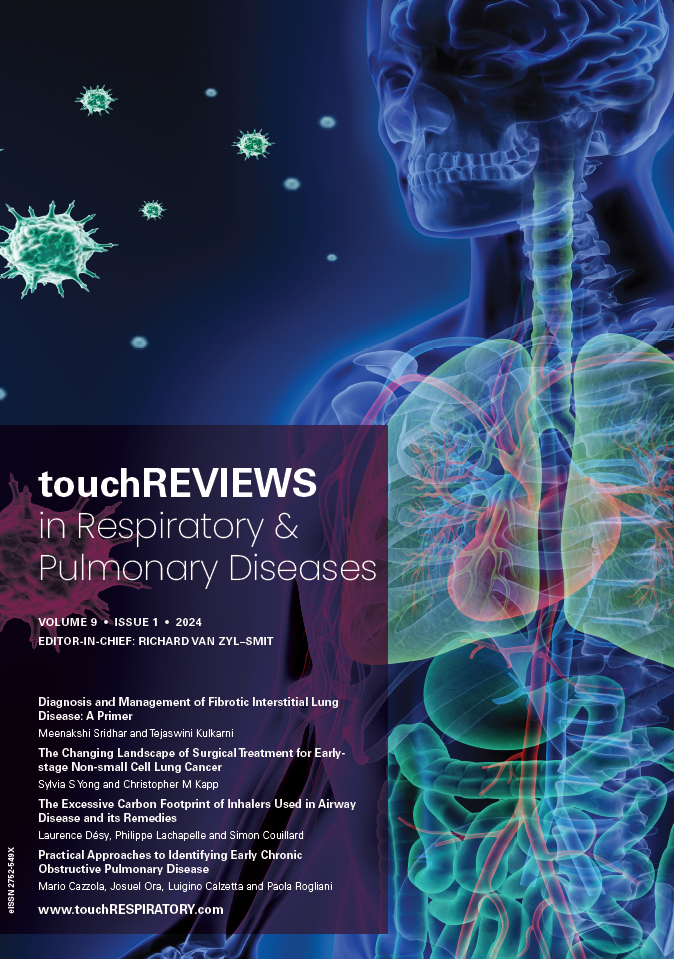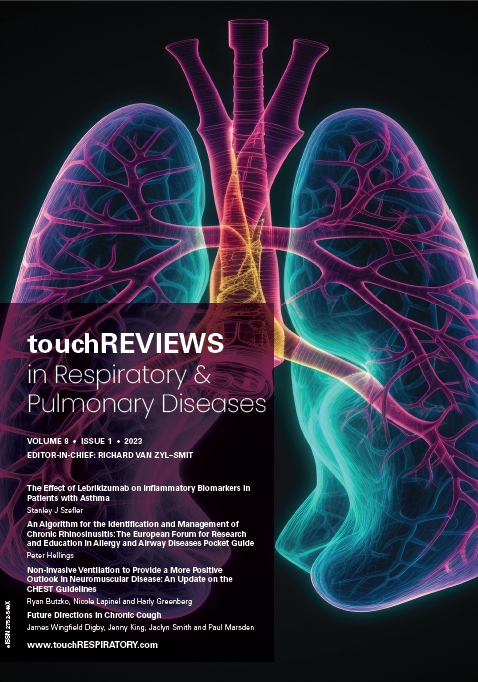US RESPIRATORY & PULMONARY DISEASES – VOLUME 2 – ISSUE 1 – WINTER 2017
Welcome to the latest edition of US Respiratory & Pulmonary Diseases! This issue includes a ‘Call for Submissions’ from Brian Carlin, and is introduced by Harly Greenberg, two highly esteemed members of our US editorial board. The issue covers a variety of topics including mechanical ventilation, COPD, sleep-disordered breathing, diffuse panbronchiolitis, lung sequestration, and thoracic ultrasound and bronchoscopy. We hope you will enjoy the compilation of expert-authored, peer-reviewed articles, as well as editorial perspective and practice pearl pieces.
We are currently accepting submissions for our 2018 edition and welcome enquiries through our submission site here.
Letter from the Editorial Board
US Respiratory & Pulmonary Diseases invites colleagues in the respiratory care and pulmonary disease community to contribute articles for the 2018 edition. US Respiratory & Pulmonary Diseases aims to provide practicing physicians, and related healthcare professionals in the field, with concise and timely articles that provide practical advice and help them in their day-to-day clinical […]
Foreword
Welcome to the latest edition of US Respiratory & Pulmonary Diseases, which features a diverse range of articles reflecting the wide spectrum of respiratory disease. We begin with a focus on chronic obstructive pulmonary disease (COPD), the third leading cause of death in the US. In an expert interview, Antonello Punturieri discusses the COPD National […]
Expert Interviews
In an expert interview, Antonello Punturieri, Program Officer at the DLD, NHLBI, NIH, discusses the COPD National Action Plan. This was the topic of his presentation which took place during a multiperspective panel discussion session at the recent 11th General Meeting of the Global Alliance Against Chronic Respiratory Diseases (GARD, supported by the World Health […]
Alzheimer’s disease (AD), the most common type of dementia, afflicts approximately 5 million people in the US, and they tend to be over the age of 60 years. By 2050, this number is projected to increase by almost three-fold to 14 million people.1 The prevalence of obstructive sleep apnea (OSA) is even higher. Depending on […]
Editorials
Pregnancy is associated with dynamic physiologic changes that may predispose women to the development, or worsening, of sleep disordered breathing. Such changes include upper airway narrowing and edema that are related to decreased oncotic pressure, the presence of estrogen receptors in the upper airway, and reduced functional residual capacity and chest wall compliance.1 In addition, […]
Dr. Bjorn Ibsen suggested to medical leaders in Copenhagen, during the 1952 polio epidemic, that positive pressure ventilation might have beneficial effects in patients with polio afflicted with respiratory failure primarily related to deficiencies in alveolar ventilation.1 The success of positive pressure mechanical ventilation in saving lives in the early 1950s led to widespread use […]
Practice Pearl
General considerations Pleural ultrasound examination can be performed in any position: supine or sitting. A low-frequency phased array transducer of 3.5–5 MHz is generally preferred for evaluation of pleural diseases. High-frequency linear transducers do not provide acceptable penetration for visualizing deep structures, but do provide better imaging of the pleural lining and better assessment of […]
Perspective
India and the US, aside from being the world’s two largest democracies with multi-ethnic communities and dynamic economies, face challenges in dealing with access to healthcare. Both countries have grappled with the demands of providing efficient and timely healthcare delivery, seeking to boost primary care and public health. It is clear that primary healthcare can […]
Review
Diffuse panbronchiolitis (DPB) is a rare inflammatory lung disease. It was first identified in 1969 and is well recognized in East Asian countries such as Japan, China, Taiwan, and Korea.1 ‘Diffuse’ and ‘pan’ words in the name indicate ‘presence of lesions through both the lungs,’ and inflammation in all layers of bronchioles. At the time […]
Original Research
Assessment of peripheral pulmonary nodules and mediastinal lymph nodes is critical in the diagnosis and staging of lung cancer, which is the leading cause of cancer death worldwide.1,2 Endobronchial ultrasound (EBUS) continues to evolve, allowing clinicians the ability to evaluate peripheral and central pulmonary lesions as well as various layers of bronchi. Current EBUS bronchoscopes […]
Case Review
Lung, pulmonary, or broncholpulmonary sequestration is a congenital disorder in which tissue that develops into lung parenchyma is not attached to the bronchial system.1 Blood supply originates from the aorta or various peripheral arteries.1,2 It is also referred to as cystic lung disease. The intralobar type accounts for approximately 75% of cases; extralobar pulmonary sequestration […]

Trending Topic
Lung cancer remains the leading cause of cancer-related death.1 However, five-year survival in lung cancer varies greatly based on the stage of the disease at diagnosis.2 Early lung cancer diagnosis through screening with low-dose computed tomography (CT) demonstrated a 20% reduction in lung cancer mortality in current or former smokers with a history of 30 or more […]
Journal Archive
US Respiratory & Pulmonary Diseases is a peer-reviewed, free-to-access, annual journal comprising review articles, case reports, practice guides, theoretical discussions, and original research. It features balanced and comprehensive articles written by leading authorities, addressing the most important and salient developments in the field of respiratory.
Latest articles videos and clinical updates - straight to your inbox
Log into your Touch Account
Earn and track your CME credits on the go, save articles for later, and follow the latest congress coverage.
Register now for FREE Access
Register for free to hear about the latest expert-led education, peer-reviewed articles, conference highlights, and innovative CME activities.
Sign up with an Email
Or use a Social Account.
This Functionality is for
Members Only
Explore the latest in medical education and stay current in your field. Create a free account to track your learning.











